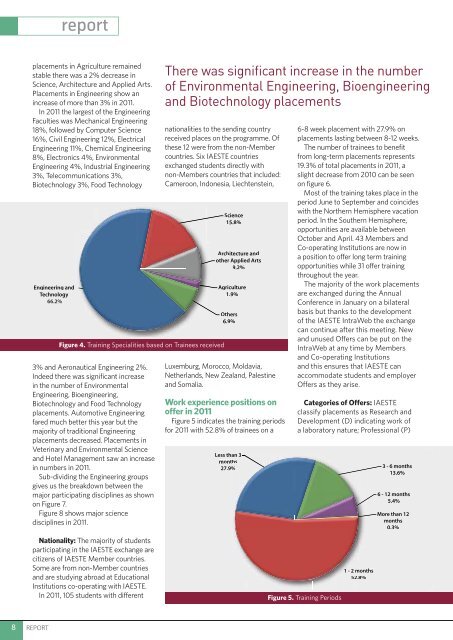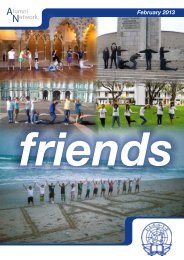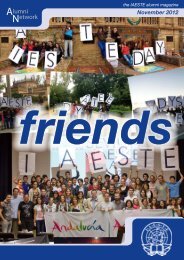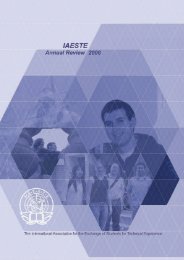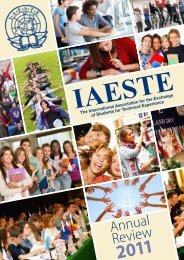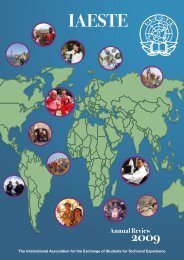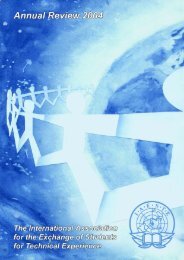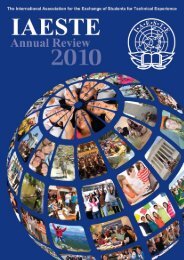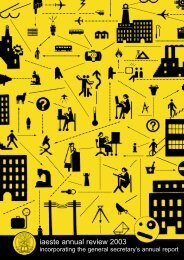View Annual Review - IAESTE
View Annual Review - IAESTE
View Annual Review - IAESTE
You also want an ePaper? Increase the reach of your titles
YUMPU automatically turns print PDFs into web optimized ePapers that Google loves.
8<br />
placements in Agriculture remained<br />
stable there was a 2% decrease in<br />
Science, Architecture and Applied Arts.<br />
Placements in Engineering show an<br />
increase of more than 3% in 2011.<br />
In 2011 the largest of the Engineering<br />
Faculties was Mechanical Engineering<br />
18%, followed by Computer Science<br />
16%, Civil Engineering 12%, Electrical<br />
Engineering 11%, Chemical Engineering<br />
8%, Electronics 4%, Environmental<br />
Engineering 4%, Industrial Engineering<br />
3%, Telecommunications 3%,<br />
Biotechnology 3%, Food Technology<br />
Engineering and<br />
Technology<br />
66.2%<br />
report<br />
3% and Aeronautical Engineering 2%.<br />
Indeed there was significant increase<br />
in the number of Environmental<br />
Engineering, Bioengineering,<br />
Biotechnology and Food Technology<br />
placements. Automotive Engineering<br />
fared much better this year but the<br />
majority of traditional Engineering<br />
placements decreased. Placements in<br />
Veterinary and Environmental Science<br />
and Hotel Management saw an increase<br />
in numbers in 2011.<br />
Sub-dividing the Engineering groups<br />
gives us the breakdown between the<br />
major participating disciplines as shown<br />
on Figure 7.<br />
Figure 8 shows major science<br />
disciplines in 2011.<br />
Nationality: The majority of students<br />
participating in the <strong>IAESTE</strong> exchange are<br />
citizens of <strong>IAESTE</strong> Member countries.<br />
Some are from non-Member countries<br />
and are studying abroad at Educational<br />
Institutions co-operating with <strong>IAESTE</strong>.<br />
In 2011, 105 students with different<br />
REPORT<br />
nationalities to the sending country<br />
received places on the programme. Of<br />
these 12 were from the non-Member<br />
countries. Six <strong>IAESTE</strong> countries<br />
exchanged students directly with<br />
non-Members countries that included:<br />
Cameroon, Indonesia, Liechtenstein,<br />
Figure 4. Training Specialities based on Trainees received<br />
There was signifi cant increase in the number<br />
of Environmental Engineering, Bioengineering<br />
and Biotechnology placements<br />
Science<br />
15.8%<br />
Architecture and<br />
other Applied Arts<br />
9.2%<br />
Agriculture<br />
1.9%<br />
Others<br />
6.9%<br />
Luxemburg, Morocco, Moldavia,<br />
Netherlands, New Zealand, Palestine<br />
and Somalia.<br />
Work experience positions on<br />
offer in 2011<br />
Figure 5 indicates the training periods<br />
for 2011 with 52.8% of trainees on a<br />
Less than 3<br />
months mont<br />
27.9%<br />
6-8 week placement with 27.9% on<br />
placements lasting between 8-12 weeks.<br />
The number of trainees to benefit<br />
from long-term placements represents<br />
19.3% of total placements in 2011, a<br />
slight decrease from 2010 can be seen<br />
on figure 6.<br />
Most of the training takes place in the<br />
period June to September and coincides<br />
with the Northern Hemisphere vacation<br />
period. In the Southern Hemisphere,<br />
opportunities are available between<br />
October and April. 43 Members and<br />
Co-operating Institutions are now in<br />
a position to offer long term training<br />
opportunities while 31 offer training<br />
throughout the year.<br />
The majority of the work placements<br />
are exchanged during the <strong>Annual</strong><br />
Conference in January on a bilateral<br />
basis but thanks to the development<br />
of the <strong>IAESTE</strong> IntraWeb the exchange<br />
can continue after this meeting. New<br />
and unused Offers can be put on the<br />
IntraWeb at any time by Members<br />
and Co-operating Institutions<br />
and this ensures that <strong>IAESTE</strong> can<br />
accommodate students and employer<br />
Offers as they arise.<br />
Categories of Offers: <strong>IAESTE</strong><br />
classify placements as Research and<br />
Development (D) indicating work of<br />
a laboratory nature; Professional (P)<br />
Figure 5. Training Periods<br />
1 - 2 months ths<br />
52.8%<br />
3 - 6 months<br />
13.6%<br />
6 - 12 months<br />
5.4%<br />
More than 12<br />
months<br />
0.3%


